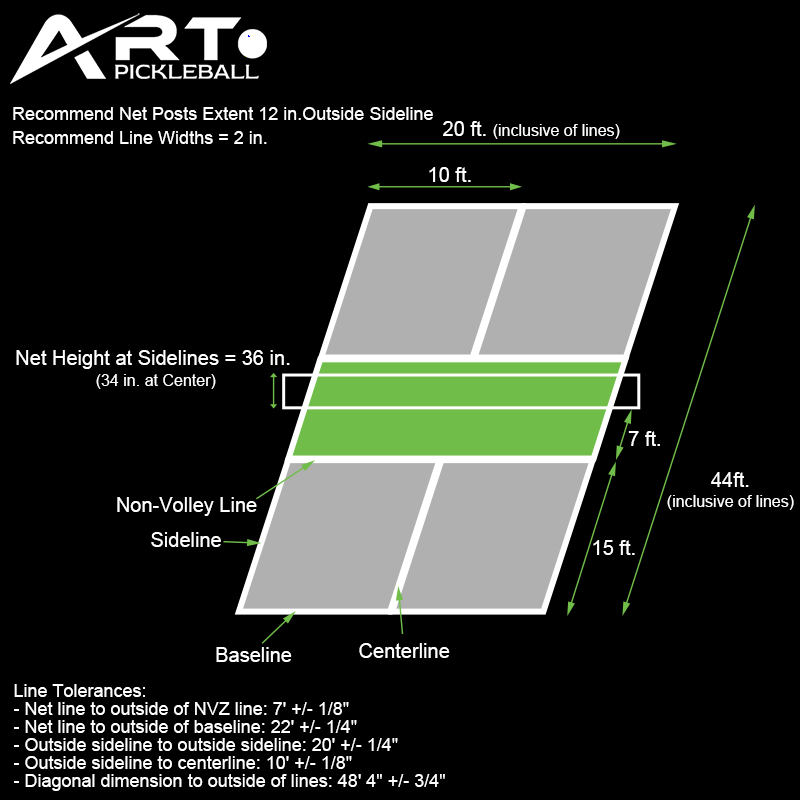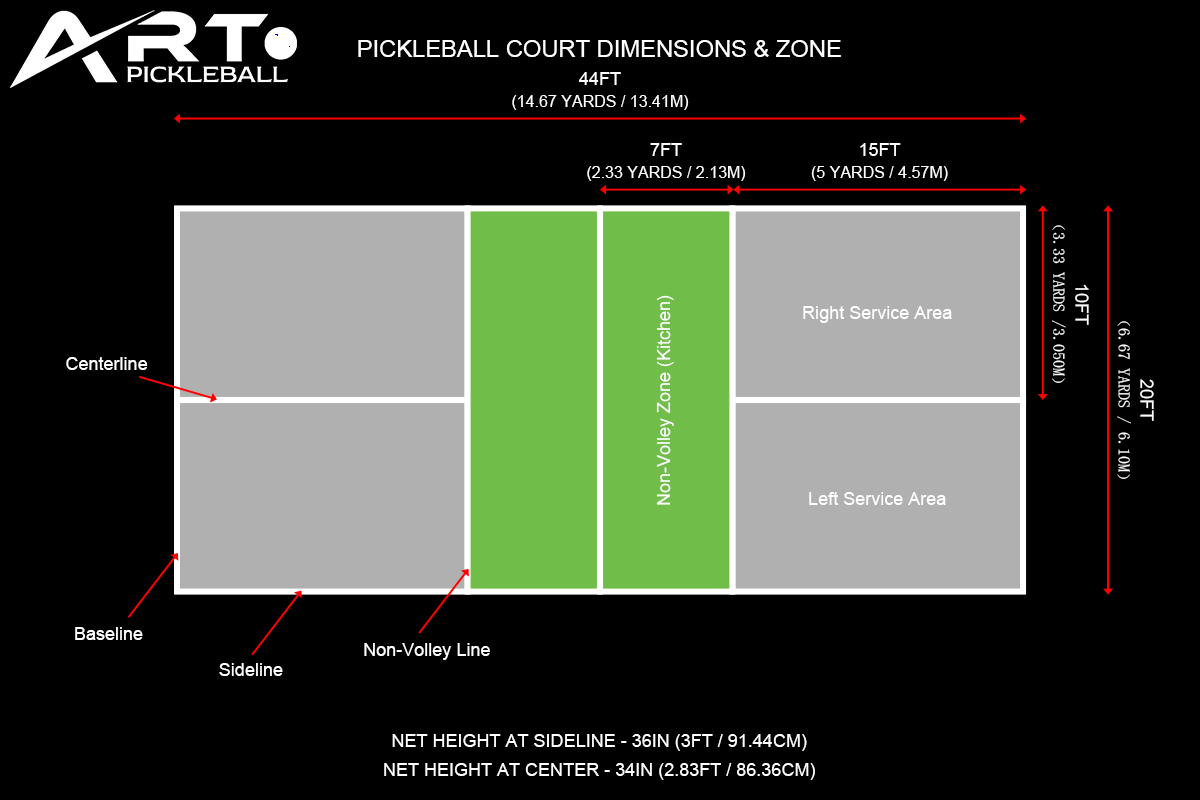Pickleball Rules: The Complete Guide (2025 Update)

CEO & Technical Expert at Pickleball Equipment Company (Art Pickleball)
Specialize in manufacturing pickleball paddles, pickleball balls, and pickleball accessories.

Pickleball might look simple at first — a paddle, a plastic ball, and a small court. But once you start playing, you quickly realise there’s more to it than just hitting the ball back and forth. Understanding the pickleball rules is what turns casual play into a real game of strategy and skill.
Whether you’re just starting out or already playing in local tournaments, learning the official rules helps you play with confidence and avoid costly mistakes.
This guide covers everything: serving, scoring, the non-volley zone (the “kitchen”), and even the 2025 rule updates from USA Pickleball. You’ll also find clear explanations, visual diagrams, and practical examples to make every rule easy to remember.
By the end, you’ll not only know the rules — you’ll play smarter, move better, and enjoy every rally a whole lot more.
Basic Rules Overview
1. Court, Equipment, and Setup
Before you dive into the finer details of play, it helps to know how a pickleball court and its equipment are set up. Everything — from the court size to the paddle you use — follows specific standards set by USA Pickleball.
Court Dimensions and Layout
A standard pickleball court measures 20 feet wide and 44 feet long, the same size for both singles and doubles. The court is divided into distinct areas:
- Baseline – The line at the back of the court where you serve from.
- Sidelines – The boundaries along each side of the court.
- Centerline – Divides the service area into two equal halves.
- Non-Volley Zone (The “Kitchen”) – A 7-foot zone on both sides of the net where volleying (hitting the ball before it bounces) is not allowed.
- Service Courts – The areas behind the kitchen where serves must land.
The net height is slightly lower than in tennis: 36 inches at the sidelines and 34 inches at the center.
Paddle and Ball Standards
Pickleball paddles are smaller than tennis rackets but larger than ping-pong paddles. They’re typically made of fiberglass, graphite, or carbon fiber for better control and power.
Paddle length + width can’t exceed 24 inches total.
Ball – A lightweight, perforated plastic ball (often called a Wiffle-style ball).
- Indoor balls have 26 larger holes.
- Outdoor balls have 40 smaller holes for wind stability.
Gear and Safety Tips
While pickleball isn’t a contact sport, wearing proper shoes and eye protection matters.
- Use court shoes with good grip (running shoes don’t offer lateral support).
- Protective eyewear is highly recommended, especially for doubles play.
- Stay hydrated and stretch before games — matches can get fast-paced quickly.
2. Match Formats
Pickleball can be played in several formats, but the most common are singles and doubles.
Singles vs Doubles
- Singles: One player per side, covering the entire court. It’s more physically demanding but great for improving footwork and endurance.
- Doubles: Two players per side — the most popular form. It focuses on coordination, teamwork, and quick net exchanges.
- Mixed Doubles: A man and woman team up on each side. Many competitive tournaments feature mixed doubles divisions.
Match Types and Scoring Structures
Official tournaments may follow different structures depending on the number of players:
- Round Robin – Everyone plays everyone else once. Great for club play or small events.
- Single Elimination – Lose once and you’re out. Fast and competitive.
- Double Elimination – You can lose one match and still fight your way back through the losers’ bracket. Most major tournaments use this format.
Scoring Basics
Pickleball uses a rally-based scoring system where points can only be scored by the serving team.
- Games are typically played to 11 points, but you must win by 2.
- Some competitive matches go to 15 or 21 points, depending on the event.
- The score is always called in three numbers: Server’s score – Receiver’s score – Server number (for doubles). Example: “4-2-1” means the serving team has 4 points, the opposing team 2, and the first server is serving.
Detailed Rules Breakdown
1. Serving Rules
Serving in pickleball sets the tone of every rally. It’s not about power — it’s about precision, control, and positioning.
The Basics
All serves must be underhand with the paddle contacting the ball below waist level.
- The server must have both feet behind the baseline when serving.
- The serve must travel diagonally across the court into the opponent’s service area.
- The ball must clear the non-volley zone (kitchen) without touching it.
Legal Serve Checklist
- Paddle moves upward on contact
- Ball struck below the waist
- Feet remain behind the baseline
- Serve lands inside the diagonal service court
If the ball clips the net but lands in the correct service box, it’s called a “let serve”, and the server gets to redo it.
Common Violations
- Foot faults — stepping on or over the baseline during serve
- Hitting the ball above waist height
- Serving into the kitchen or wrong service box
2. The Double-Bounce Rule
One of the most unique features in pickleball is the double-bounce rule (also called the two-bounce rule).
Here’s how it works:
- After the serve, the receiving team must let the ball bounce once before returning it.
- Then, the serving team must also let it bounce once before hitting it.
- Only after both sides have allowed a bounce can players start volleying (hitting the ball in the air).
This rule keeps rallies fair, reduces serve-and-volley dominance, and gives both sides a chance to get into position.
Quick tip: Watch how the ball behaves after the second bounce — that’s usually when smart players move forward to control the kitchen line.
3. The Non-Volley Zone (The Kitchen)
The non-volley zone — nicknamed “the kitchen” — is a 7-foot area on both sides of the net that controls where volleys can happen.
Core Rule
You cannot volley (hit the ball out of the air) while standing in the kitchen or even touching the line.
If your foot, paddle, or any part of your body contacts the kitchen during a volley, it’s a fault.
You Can
- Step into the kitchen after the ball bounces there.
- Hit the ball out of a bounce within the zone.
- Move freely through it as long as you don’t volley.
You Can’t
- Volley with even one toe touching the kitchen line.
- Lean over the kitchen and volley mid-air.
- Lose balance into the kitchen after a volley — even if the ball is already dead.
Pro insight: The best doubles teams “own the kitchen line” — they stay right behind it, volleying aggressively but never stepping in.
4. Scoring and Side Rotation
Pickleball uses a side-out scoring system — only the serving team can earn points.
Scoring System
- Games are usually played to 11 points (win by 2).
- The serving team continues serving until they commit a fault.
- In doubles, each partner serves before the serve passes to the other team.
Calling the Score
Scores are always called in three numbers: Server’s score – Receiver’s score – Server number (1 or 2).
Example: If the serving team has 5 points, the receivers 3, and it’s the first server’s turn: “5–3–1”.
When the second server finishes and loses the rally, it’s called “side out”, and the other team starts serving.
5. Faults and Violations
A fault ends the rally immediately. Here are the main ways it can happen:
| Type | Example | Result |
|---|---|---|
| Foot Fault | Server steps on baseline | Loss of serve |
| Kitchen Violation | Volley while touching the kitchen line | Loss of rally |
| Double Bounce | Ball bounces twice before hit | Loss of rally |
| Out of Bounds | Ball lands outside lines | Loss of rally |
| Touching the Net | Any body or paddle contact with net | Loss of rally |
| Wrong Server / Receiver | Serving or receiving out of turn | Replay or point to opponent |
Replay Situations
Sometimes, referees may call a replay (let) in unclear situations — for instance, a ball that barely grazes the net cord or a disputed line call without agreement.
6. Game Flow and Strategy in Action
Beyond knowing the rules, the best players use them to their advantage.
- Serve deep, return deep. This pushes your opponent back and gives you time to reach the kitchen line.
- Play the soft game. Dinks and controlled volleys keep your rivals off-balance.
- Communicate in doubles. Call “mine” or “yours” clearly — confusion leads to easy faults.
- Stay calm on faults. Even pros step into the kitchen by accident. Learn, reset, and move on.
Not sure which rules matter most when you’re starting out? Read our beginner-friendly breakdown of the key 10 pickleball rules before diving into advanced play.
Strategies, Tips & Common Questions
Understanding the court dimensions is one thing.
But knowing how to use them strategically — that’s what separates casual players from those who dominate the game.
Let’s dive into some practical tips, positioning insights, and answers to common court-related questions.
1. Smart Court Positioning Strategies
Pickleball isn’t just about power — it’s about placement and precision.
Here’s how mastering the court layout can give you a tactical edge:
| Zone | Strategic Focus | Expert Tip |
|---|---|---|
| Non-Volley Zone (NVZ) | Control the pace and play soft shots | Stay light on your feet and avoid stepping into the kitchen unless necessary |
| Baseline Area | Great for deep serves and returns | Aim your serve to the opponent’s backhand to force weak returns |
| Sidelines | Control space and limit your opponent’s angles | Keep your shots low and within the lines to avoid easy volleys |
| Centerline | Acts as your positioning reference | After each shot, return to centre position to prepare for the next rally |
Pro tip: Use the “split-step” technique — a tiny hop before your opponent hits the ball. It helps you react quicker and adjust your stance for any direction.
2. Advanced Tactics: Reading the Court Like a Pro
Once you’re confident with the zones, it’s time to play smarter:
Exploit Open Space:
Notice where your opponent isn’t. Aim your shots there, even if it’s a softer one — control always beats chaos.
Dominate the Kitchen Line:
Teams that control the NVZ line usually win more rallies. Move up fast after your serve and cut off high balls early.
Play to the Angles:
Hit diagonally across the court — it gives you more space, reduces error chances, and forces your opponent to move.
Use the Width Wisely:
Make your opponent run. Wide serves and cross-court dinks stretch them out, opening the middle for your next shot.
Stay Balanced Between Offense and Defence:
Don’t overreach or lunge too much — maintain posture. A stable stance equals faster recovery and sharper responses.
3. Common Mistakes to Avoid
Even experienced players slip up sometimes.
Here are the top court-related errors to look out for:
- Standing too far back from the NVZ line — you lose control of the rally.
- Overstepping into the kitchen during a volley — that’s a fault.
- Ignoring positioning — failing to reset to the centre can expose your sides.
- Hitting serves too short — it gives your opponent an easy return opportunity.
- Misjudging sidelines — always practise accuracy, not just power.
Remember, pickleball rewards patience and precision, not just aggressive shots.
4. FAQs About On-Court Strategy
Q1: How close should I stand to the kitchen line?
Ideally, with your toes just behind the line — about 1–2 inches. This position allows you to volley effectively without risking a foot fault.
Q2: What’s the best position for doubles play?
Both players should aim to reach the kitchen line together after the serve return, maintaining a side-by-side stance to cover the width.
Q3: How can I improve my court awareness?
Practise drills that involve peripheral vision — like shadow rallies or calling out line zones as you move. It trains your mind to read the court instinctively.
Q4: Should I focus more on power or placement?
Always placement first. Power without control leads to unforced errors, while precise shots win points.
Q5: What’s the biggest difference between singles and doubles strategy?
In singles, mobility and endurance are key. In doubles, teamwork and positioning dominate. The court size is the same — but the mental game changes entirely.
Visual Guide to Pickleball Court Layout and Dimensions
Understanding pickleball rules is one thing — seeing how those rules fit on the court is another.
That’s why visuals make such a big difference. A clear diagram or layout helps players quickly connect each rule to its real-world space on the court.
If you’d like to dive deeper into exact pickleball court dimensions — including measurements, setup tips, and court layout standards — we’ve covered everything in detail in The Complete Guide to Pickleball Court Dimensions.
Below, you’ll find a series of visuals and resources that bring the game to life:
1. Official Pickleball Court Diagram

A standard pickleball court measures 20 feet wide by 44 feet long, and this layout is the same for both singles and doubles play.
In your diagram, make sure the following areas are clearly marked:
- Baselines and Sidelines – define the outer boundaries of the court.
- Non-Volley Zone (The Kitchen) – a 7-foot zone on each side of the net.
- Centreline – splits the service area into left and right halves.
- Service Courts – where the ball must land after a serve.
- Net Height – 36 inches at the posts and 34 inches at the center.
Tip: Use color to separate each zone — for example, shade the kitchen area light blue and the service boxes green for quick visual clarity.
2. Measurement Reference Chart
For players or court builders who prefer numbers, a dimension chart is your go-to quick reference.
| Area | Measurement (Feet) | Measurement (Meters) |
|---|---|---|
| Full Court | 20 × 44 ft | 6.10 × 13.41 m |
| Service Area | 10 × 15 ft (each side) | 3.05 × 4.57 m |
| Non-Volley Zone | 7 ft (each side) | 2.13 m |
| Net Height (Center) | 34 in | 0.86 m |
| Net Height (Sidelines) | 36 in | 0.91 m |
Tip: A well-labelled chart helps coaches, players, and venue managers verify the court setup quickly without pulling out a tape measure.
3. Zoning Illustration: Understanding Court Function

A zoning illustration makes the court layout intuitive.
Each section serves a purpose — and when you know them, you can start to strategize around them.
- Kitchen (Non-Volley Zone): Dictates the pace of play — soft shots here win points.
- Service Courts: The launch pads for rallies — keep serves deep and accurate.
- Sidelines & Baselines: Define in or out — aim close but stay safe.
- Centreline: Your positioning guide — helps maintain court balance after every shot.
Pro insight: Most top doubles teams dominate rallies by controlling the area right behind the kitchen line — a position you’ll see clearly marked in your diagram.
Official Rule Resources & Updates
Pickleball is constantly evolving — and so are its rules.
To make sure your knowledge stays current, it’s essential to refer to the official sources and updates released by the sport’s governing bodies.
Below are the key references and tools that every serious player, coach, or organiser should know.
1. USA Pickleball Official Rulebook (2025 Edition)
The USA Pickleball Rulebook is the gold standard for all official play across the United States and most international tournaments.
It covers everything from court specifications and scoring rules to officiating procedures and equipment guidelines.
- Download the full 2025 Rulebook: USA Pickleball Official Rules
- Updated annually — usually released each December with changes effective from January.
- Includes new amendments, clarified definitions, and illustrations for rule interpretation.
Pro Tip: Even recreational players benefit from reading the latest rulebook. Small details — like serve techniques or line-call interpretations — can affect real matches.
2. Summary of Recent Rule Changes (2025 Highlights)
Each year, USA Pickleball introduces updates to make gameplay fairer and safer.
Here are a few key highlights from the latest updates:
| Year | Focus Area | What Changed |
|---|---|---|
| 2025 | Serve motion | Clarified waist-level definition and paddle angle limits |
| 2025 | Equipment | New testing standards for paddle surface texture |
| 2025 | Replay rules | Expanded criteria for referee-overturned points |
| 2024 | Line calls | Players now allowed to request referee confirmation more flexibly |
| 2024 | Fault review | Simplified double-bounce and net-touch definitions |
Note: Always double-check with the latest rulebook or your tournament organiser — not all changes apply to local or non-sanctioned play.
3. International Rules & Organisations
While the USA Pickleball rulebook leads globally, other countries have local adaptations managed by regional federations.
| Organisation | Region | Rule Basis |
|---|---|---|
| Pickleball Canada | Canada | Follows USA Pickleball with minor modifications |
| Pickleball England | UK & Europe | Aligned with USA Pickleball standards |
| IFP (International Federation of Pickleball) | Global | Promotes international rule consistency |
| Asia Pickleball Association (APA) | Asia-Pacific | Adopts IFP standards with local flexibility |
Tip: If you’re travelling or playing abroad, check the local federation website for rule variations — especially on serve motion and court surface regulations.
4. Why Staying Updated Matters
Knowing the rules isn’t just about avoiding faults — it’s about playing smarter.
When you understand every line, zone, and exception, you gain a tactical advantage and help maintain the integrity of the sport.
Whether you’re coaching new players, running local leagues, or just want to play like a pro, staying current with official rule updates keeps you one step ahead.
Conclusion
By now, you’ve got a complete understanding of how pickleball rules shape the game — from how serves work and what the kitchen is, to how points are scored and why court positioning matters.
The truth is, once you fully grasp the rules, pickleball becomes even more fun. You stop guessing, start strategising, and find yourself making smarter plays without overthinking. Whether you’re playing casually with friends or joining official tournaments, knowing the official rules gives you confidence and a real edge on the court.
But don’t stop here.
Rules are just the foundation — the real improvement happens when you combine that knowledge with the right equipment and mindset.
If you’re ready to take your game further, explore our guides and products designed for serious players:
Need high-performance paddles, balls, and custom court gear?
Check out Art Pickleball — we design and manufacture professional-grade pickleball equipment trusted by players and clubs worldwide.
